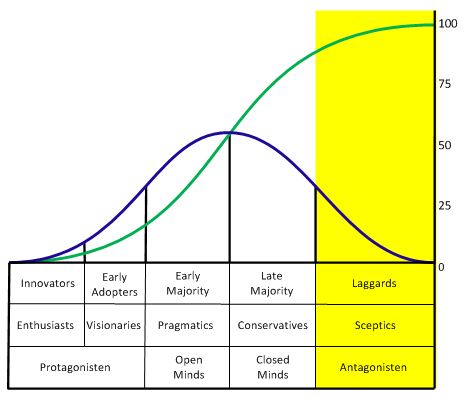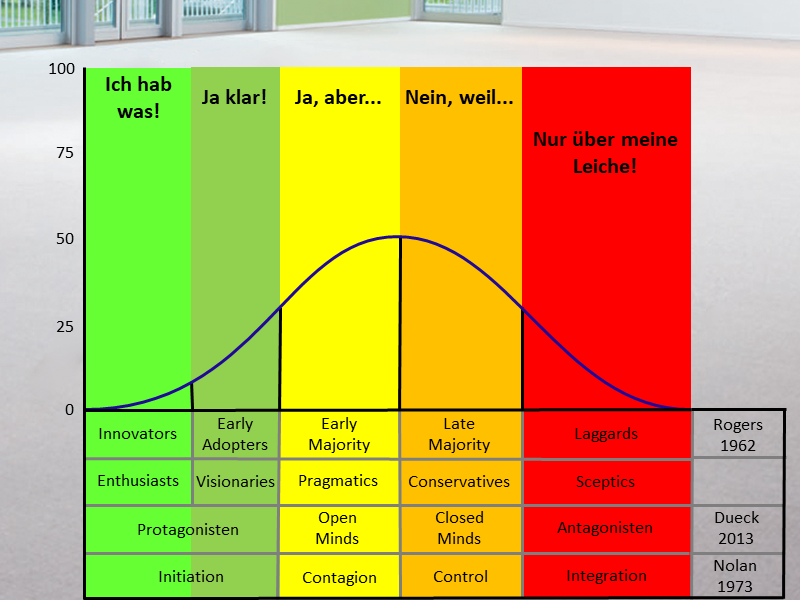laggard laggard |

|
 Definitionen
Definitionen
 Die Skeptiker (Laggards ) wehren sich im Gegensatz zur späten Mehrheit aktiv gegen die Neuerung und versuchen, diese zu verhindern.
Leitmotiv : »Nur über meine Leiche!«
Die Skeptiker (Laggards ) wehren sich im Gegensatz zur späten Mehrheit aktiv gegen die Neuerung und versuchen, diese zu verhindern.
Leitmotiv : »Nur über meine Leiche!«
 Die Skeptiker (laggards) sind grundsätzlich misstrauisch gegenüber neuen Produkten,
Methoden oder Denkweisen. Oft arbeiten sie sogar aktiv gegen deren
Einführung. (Leitmotiv: „Nur über meine Leiche“).
Die Skeptiker (laggards) sind grundsätzlich misstrauisch gegenüber neuen Produkten,
Methoden oder Denkweisen. Oft arbeiten sie sogar aktiv gegen deren
Einführung. (Leitmotiv: „Nur über meine Leiche“). Finally there are the laggards. These people simply don’t want anything to
do with new technology, for any of a variety of reasons, some personal and
some economic. The only time they ever buy a technological product is when
it is buried so deep inside another product—the way, say, that a microprocessor
is designed into the braking system of a new car—that they don’t even
know it is there. Laggards are generally regarded as not worth pursuing on any
other basis.
Finally there are the laggards. These people simply don’t want anything to
do with new technology, for any of a variety of reasons, some personal and
some economic. The only time they ever buy a technological product is when
it is buried so deep inside another product—the way, say, that a microprocessor
is designed into the braking system of a new car—that they don’t even
know it is there. Laggards are generally regarded as not worth pursuing on any
other basis. Rogers untersuchte schon 1962 in seinem Buch Diffusion of Innovations die Ausbreitung von Innovationen in einer Bevölkerung. Zuerst gibt es die Idee oder Vision eines Erfinders oder Innovators, dann bauen Innovatoren erste Prototypen, die schon von den ersten technisch Interessierten (»Early Adopters« oder »Erstanwender«) benutzt werden. Diese ersten Anwender verbessern entweder selbst oder durch konstruktive Kritik die ersten Prototypen, sodass die neue Erfindung langsam reift und schließlich so gut wird, dass sie die fortschrittlich denkende »erste Hälfte« der Menschen nützlich findet. Jetzt erst ist aus der Erfindung eine wirkliche Innovation geworden. Die »Pragmatics« haben die Innovation für sich selbst als nützlich akzeptiert! Die konservative Hälfte der Menschen freundet sich mit der Innovation erst später oder viel später an, ein letzter Rest vielleicht nie (»Ich bin stolz, jetzt schon seit 50 Jahren keinen Fernseher zu besitzen.«).
Rogers untersuchte schon 1962 in seinem Buch Diffusion of Innovations die Ausbreitung von Innovationen in einer Bevölkerung. Zuerst gibt es die Idee oder Vision eines Erfinders oder Innovators, dann bauen Innovatoren erste Prototypen, die schon von den ersten technisch Interessierten (»Early Adopters« oder »Erstanwender«) benutzt werden. Diese ersten Anwender verbessern entweder selbst oder durch konstruktive Kritik die ersten Prototypen, sodass die neue Erfindung langsam reift und schließlich so gut wird, dass sie die fortschrittlich denkende »erste Hälfte« der Menschen nützlich findet. Jetzt erst ist aus der Erfindung eine wirkliche Innovation geworden. Die »Pragmatics« haben die Innovation für sich selbst als nützlich akzeptiert! Die konservative Hälfte der Menschen freundet sich mit der Innovation erst später oder viel später an, ein letzter Rest vielleicht nie (»Ich bin stolz, jetzt schon seit 50 Jahren keinen Fernseher zu besitzen.«). Laggards are the last in a social system to adopt an innovation. They
possess almost no opinion leadership. They are the most localite in
their outlook of all adopter categories; many are near isolates in social
networks. The point of reference for the laggard is the past. Decisions
are often made in terms of what has been done in previous generations
and these individuals interact primarily with others who also have
relatively traditional values. When laggards finally adopt an innovation,
it may already have been superseded by another more recent idea
that is already being used by the innovators. Laggards tend to be
frankly suspicious of innovations and change agents. Their traditional
orientation slows the innovation-decision process to a crawl, with
adoption lagging far behind awareness-knowledge of a new idea.
While most individuals in a social system are looking to the road of
change ahead, the laggard's attention is fixed on the rear-view mirror.
Laggards are the last in a social system to adopt an innovation. They
possess almost no opinion leadership. They are the most localite in
their outlook of all adopter categories; many are near isolates in social
networks. The point of reference for the laggard is the past. Decisions
are often made in terms of what has been done in previous generations
and these individuals interact primarily with others who also have
relatively traditional values. When laggards finally adopt an innovation,
it may already have been superseded by another more recent idea
that is already being used by the innovators. Laggards tend to be
frankly suspicious of innovations and change agents. Their traditional
orientation slows the innovation-decision process to a crawl, with
adoption lagging far behind awareness-knowledge of a new idea.
While most individuals in a social system are looking to the road of
change ahead, the laggard's attention is fixed on the rear-view mirror. Bemerkungen
Bemerkungen
 Skeptics - the group that makes up the last one-sixth of the Technology
Adoption Life Cycle - do not participate in the high-tech marketplace, except
to block purchases. Thus, the primary function of high-tech marketing in
relation to skeptics is to neutralize their influence. In a sense, this is a pity
because skeptics can teach us a lot about what we are doing wrong.
Skeptics - the group that makes up the last one-sixth of the Technology
Adoption Life Cycle - do not participate in the high-tech marketplace, except
to block purchases. Thus, the primary function of high-tech marketing in
relation to skeptics is to neutralize their influence. In a sense, this is a pity
because skeptics can teach us a lot about what we are doing wrong. The five adopter categories set forth in this chapter are ideal types.
Ideal types are conceptualizations based on observations of reality
and designed to make comparisons possible. The function of ideal
types is to guide research efforts and to serve as a framework for the
synthesis of research findings.
The five adopter categories set forth in this chapter are ideal types.
Ideal types are conceptualizations based on observations of reality
and designed to make comparisons possible. The function of ideal
types is to guide research efforts and to serve as a framework for the
synthesis of research findings.Actually, there are no pronounced breaks in the innovativeness continuum between each of the five categories. Ideal types are not simply an average of all observations about an adopter category. Exceptions to the ideal types must be found. If no exceptions or deviations could be located, ideal types would not be necessary. Ideal types are based on abstractions from empirical cases and are intended as a guide for theoretical formulations and empirical investigations. They are not, however, a substitute for these investigations.
 Verwandte Objeke
Verwandte Objeke
 Verwandte Begriffe (co-word occurance) |  late majority late majority late majority(0.58), late majority(0.58),  early majority early majority early majority(0.55), early majority(0.55),  innovator innovator innovator(0.39), innovator(0.39),  Early Adopter Early Adopter Early Adopter(0.37) Early Adopter(0.37) |
 Häufig co-zitierte Personen
Häufig co-zitierte Personen
 Statistisches Begriffsnetz
Statistisches Begriffsnetz 
 6 Vorträge von Beat mit Bezug
6 Vorträge von Beat mit Bezug
- 0 und 1 aber nicht schwarz/weiss
Der Leitmedienwechsel und das Schweizerische Bildungswesen
GDI Rüschlikon, 12.03.2013



- We are all excited - but why?
Opening Keynote (Video of the keynote together with Mitch Resnick)
Scratch Conference, Amsterdam, 13.08.2015

- Der digitale Leitmedienwechsel als Herausforderung für Schulleitungen und Schulbehörden
11. Symposium Personalmanagement im Bildungsbereich, PHZH, Zürich, 19.05.2017

- LehrerInnenbildung in einer digitalisierten Welt
KMK-Konferenz "Dimension Digitalisierung – Lehrkräfte stärken", Hamburg, 19.06.2018

- Digitalisieren Sie noch?
ICT-Kadertag "Begleiten in der Mediengesellschaft" der PHZG
Gemeindesaal Steinhausen, 16.09.2020

 2 Einträge in Beats Blog
2 Einträge in Beats Blog
 Zitationsgraph
Zitationsgraph
 Zeitleiste
Zeitleiste
 16 Erwähnungen
16 Erwähnungen 
- The diffusion process - Special Report No. 18 (Joe M. Bohlen, George M. Beal) (1957)


- Diffusion of Innovations (E. M Rogers) (1962)

- Crossing the Chasm - Marketing and Selling High-Tech Products to Mainstream Customers (Geoffrey A. Moore) (1991)

- The Invisible Computer - Why Good Products Can Fail, the Personal Computer Is So Complex and Information Applicances Are the Solution (Donald A. Norman) (1999)


- One-to-one technology-enhanced learning - An opportunity for global research collaboration (Tak-Wai Chan, Jeremy Roschelle, S. Hsi, Kinshuk, Mike Sharples, Tom Brown, Charles Patton, J. Cherniavsky, Roy Pea, Cathleen Norris, Elliot Soloway, N. Balacheff, Marlene Scardamalia, Pierre Dillenbourg, C. Looi, M. Milrad, Heinz Ulrich Hoppe) (2006)


- 50 Erfolgsmodelle - Kleines Handbuch für strategische Entscheidungen (Mikael Krogerus, Roman Tschäppeler) (2008)


- International Handbook of Information Technology in Primary and Secondary Education (Joke Voogt, Gerald Knezek) (2009)
- Lernplattformen in Schulen - Ansätze für E-Learning und Blended Learning in Präsenzklassen (Dominik Petko) (2010)


- Wie das Neue in die Welt kommt - Vortrag am 08.10.2012 bei den http://www.experimentdays.mixxt.de auf dem Bernhäuser Forst von ejw, ptz und rpi-virtuell (Gunter Dueck) (2012)


- Das Neue und seine Feinde - Wie Ideen verhindert werden und wie sie sich trotzdem durchsetzen (Gunter Dueck) (2013)


- Understanding the Technology Adoption Curve in Education (Atomic Learning) (2013)


- BYOD - Integration mobiler Geräte in der Schule - Wie kann die Schulleitung eine sinnvolle Integration von persönlichen, mobilen Geräten der Schülerinnen und Schüler ermöglichen? (Christian Neff) (2015)


- Mehr als 0 und 1 - Schule in einer digitalisierten Welt (Beat Döbeli Honegger) (2016)


- Medien und Schule - Unterrichten mit Whiteboard, Smartphone und Co. (Heike Schaumburg, Doreen Prasse) (2018)


- Digital Leadership - Schulen im digitalen Wandel führen (Tobias Röhl, Johannes Breitschaft, Eliane Burri, Nicole Wespi) (2023)











 Geoffrey A.
Geoffrey A. Armin
Armin Jeremy
Jeremy
 Biblionetz-History
Biblionetz-History